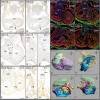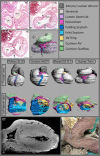Evolution and development of ventricular septation in the amniote heart
- PMID: 25192012
- PMCID: PMC4156344
- DOI: 10.1371/journal.pone.0106569
Evolution and development of ventricular septation in the amniote heart
Abstract
During cardiogenesis the epicardium, covering the surface of the myocardial tube, has been ascribed several functions essential for normal heart development of vertebrates from lampreys to mammals. We investigated a novel function of the epicardium in ventricular development in species with partial and complete septation. These species include reptiles, birds and mammals. Adult turtles, lizards and snakes have a complex ventricle with three cava, partially separated by the horizontal and vertical septa. The crocodilians, birds and mammals with origins some 100 million years apart, however, have a left and right ventricle that are completely separated, being a clear example of convergent evolution. In specific embryonic stages these species show similarities in development, prompting us to investigate the mechanisms underlying epicardial involvement. The primitive ventricle of early embryos becomes septated by folding and fusion of the anterior ventricular wall, trapping epicardium in its core. This folding septum develops as the horizontal septum in reptiles and the anterior part of the interventricular septum in the other taxa. The mechanism of folding is confirmed using DiI tattoos of the ventricular surface. Trapping of epicardium-derived cells is studied by transplanting embryonic quail pro-epicardial organ into chicken hosts. The effect of decreased epicardium involvement is studied in knock-out mice, and pro-epicardium ablated chicken, resulting in diminished and even absent septum formation. Proper folding followed by diminished ventricular fusion may explain the deep interventricular cleft observed in elephants. The vertical septum, although indistinct in most reptiles except in crocodilians and pythonidsis apparently homologous to the inlet septum. Eventually the various septal components merge to form the completely septated heart. In our attempt to discover homologies between the various septum components we aim to elucidate the evolution and development of this part of the vertebrate heart as well as understand the etiology of septal defects in human congenital heart malformations.
Conflict of interest statement
Figures






Similar articles
-
The Epicardium in Ventricular Septation During Evolution and Development.2016 Jun 25. In: Nakanishi T, Markwald RR, Baldwin HS, Keller BB, Srivastava D, Yamagishi H, editors. Etiology and Morphogenesis of Congenital Heart Disease: From Gene Function and Cellular Interaction to Morphology [Internet]. Tokyo: Springer; 2016. Chapter 13. 2016 Jun 25. In: Nakanishi T, Markwald RR, Baldwin HS, Keller BB, Srivastava D, Yamagishi H, editors. Etiology and Morphogenesis of Congenital Heart Disease: From Gene Function and Cellular Interaction to Morphology [Internet]. Tokyo: Springer; 2016. Chapter 13. PMID: 29787105 Free Books & Documents. Review.
-
Reptilian heart development and the molecular basis of cardiac chamber evolution.Nature. 2009 Sep 3;461(7260):95-8. doi: 10.1038/nature08324. Nature. 2009. PMID: 19727199 Free PMC article.
-
Role of the left interventricular sulcus in formation of interventricular septum and crista supraventricularis in normal human cardiogenesis.Anat Rec. 1979 Jul;194(3):417-28. doi: 10.1002/ar.1091940308. Anat Rec. 1979. PMID: 475007
-
New findings concerning ventricular septation in the human heart. Implications for maldevelopment.Circulation. 1992 Oct;86(4):1194-205. doi: 10.1161/01.cir.86.4.1194. Circulation. 1992. PMID: 1382888
-
Reptiles as a Model System to Study Heart Development.Cold Spring Harb Perspect Biol. 2020 May 1;12(5):a037226. doi: 10.1101/cshperspect.a037226. Cold Spring Harb Perspect Biol. 2020. PMID: 31712265 Free PMC article. Review.
Cited by
-
High heart rate associated early repolarization causes J-waves in both zebra finch and mouse.Physiol Rep. 2021 Mar;9(5):e14775. doi: 10.14814/phy2.14775. Physiol Rep. 2021. PMID: 33709567 Free PMC article.
-
Sequential segmental analysis of the crocodilian heart.J Anat. 2017 Oct;231(4):484-499. doi: 10.1111/joa.12661. Epub 2017 Aug 1. J Anat. 2017. PMID: 28766716 Free PMC article.
-
Single ventricle: amphibians and human beings.World J Pediatr. 2022 Oct;18(10):643-646. doi: 10.1007/s12519-022-00595-5. World J Pediatr. 2022. PMID: 35939203 No abstract available.
-
Outflow tract septation and the aortic arch system in reptiles: lessons for understanding the mammalian heart.Evodevo. 2017 May 10;8:9. doi: 10.1186/s13227-017-0072-z. eCollection 2017. Evodevo. 2017. PMID: 28491275 Free PMC article.
-
14-3-3epsilon controls multiple developmental processes in the mouse heart.Dev Dyn. 2016 Nov;245(11):1107-1123. doi: 10.1002/dvdy.24440. Epub 2016 Sep 18. Dev Dyn. 2016. PMID: 27580238 Free PMC article.
References
-
- Holmes EB (1975) A reconsideration of the phylogeny of the tetrapod heart. J Morphol 147: 209–228. - PubMed
-
- Jacobs JP, Quintessenza JA, Burke RP, Mavroudis C (2000) Congenital Heart Surgery Nomenclature and Database Project: atrial septal defect. Ann Thorac Surg 69: S18–S24. - PubMed
-
- Gittenberger-de Groot AC, Vrancken Peeters M-PFM, Mentink MMT, Gourdie RG, Poelmann RE (1998) Epicardium-derived cells contribute a novel population to the myocardial wall and the atrioventricular cushions. Circ Res 82: 1043–1052. - PubMed
Publication types
MeSH terms
Substances
LinkOut - more resources
Full Text Sources
Other Literature Sources

